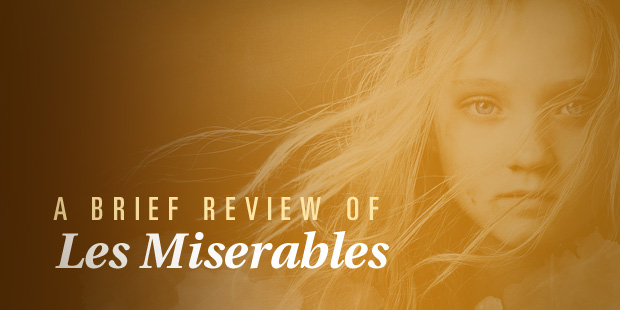
A Brief Review of Les Miserables
Ever since the trailer for the new Les Misérables movie made the rounds online, I’ve been highly anticipating this film. Last weekend, Corina and I went to see it. We were not disappointed, but we were surprised in ways different than expected.
Here are some initial thoughts.
(Caution: Spoilers ahead!)
From Book to Broadway to the Box Office
How does one judge the faithfulness of a screen adaptation of Les Misérables?
Do we judge it based on its fidelity to the book? To the musical? To the spirit of both?
If you’ve read the book, you can imagine the difficulty of translating such a sprawling piece of literature to the big screen. Directors and screenwriters have tried and, in my estimation, failed. (Even Liam Neeson.) It’s simply too hard to pack the emotional punch of Hugo’s masterpiece into a two-hour film.
Unless… you’ve got music on your side. This is where the musical excels. By telling the story musically, the composers capture the spirit of Hugo’s novel without slavishly following every detail.
I am a fan of the book. I am a fan of the musical. Now, finally, I am a fan of the movie. Hooper deserves accolades for pulling it off.
Anne Hathaway as Fantine
Anne Hathaway’s performance as Fantine has gotten a lot of buzz, deservedly so. Her gut-wrenching version of “I Dreamed a Dream” rescues the song from the sentimentality of Susan Boyle and reminds viewers of the despairing lyrics that work against the soaring melody. Also powerful is the deathbed scene where Fantine longs for her daughter.
Because Hathaway has received so much buzz, I can’t say I was surprised by the emotional depth of her performance. She lived up to the hype, but didn’t exceed expectations (perhaps because expectations were so high). Likewise, Hugh Jackman did a fantastic job capturing the progression of Valjean from sinner to saint.
Marius’ Empty Chairs
What surprised me most was Eddie Redmayne’s performance as Marius. His rendition of “Empty Chairs at Empty Tables” was so authentic that, for a moment, I felt as if I were in the room with him, feeling the same wave of anger and grief he was experiencing. It was a stunning performance. Corina and I looked at each other after it was over and said, “Unbelievable.”
The Killing of Gavroche
After the tragedy in Connecticut, it was especially difficult to watch the little boy Gavroche get killed at the barricade. The film didn’t belabor the tragedy by showing blood; even so, the sight of a young child being shot and killed was disturbing. (There were audible gasps in the audience when this took place on screen.)
Christian Imagery
I was also surprised by the pervasiveness of Christian imagery in the film. The clearest use of the cross was saved for Valjean’s moment of truth, as he faces the inner conflict of choosing to reveal himself in order to save the life of another man. While Valjean sings these words, he is looking at a crucifix:
Can I condemn this man to slavery
Pretend I do not feel his agony
This innocent who bears my face
Who goes to judgment in my place
Christian Resonance
While Les Misérables was playing, we could hear people weeping. When it was finished, the movie-goers burst into applause.
The “experience” of this movie got me thinking. How many people are moved by Les Misérables without really knowing why?
Is it the portrait of law and grace? Valjean – a man who offers grace without conditions, set against the backdrop of Javert, who in his pride would rather die than be humbled before a thief.
Is it the light of grace shining in darkness? We see the ugliness of sin: theft, hypocrisy, and immorality. The darkness of evil makes the light of love shine all the brighter.
Is it the hope of heaven? As Valjean dies, Fantine sings about how he will soon enter his reward – seeing God. The end of the movie is shot through with eschatology:
Even the darkest night will end and the sun will rise.
They will live again in the freedom in the garden of the Lord…
Somewhere beyond the barricade is there a world you long to see?
I wonder how many people long for the better world behind the barricade, but don’t know how to get there. Moved to tears by grace-on-display in the character of a man who lays down his life for others, they miss the connections between this literary classic and the greatest Story ever told.
The music written for the grand narrative of Scripture can’t be contained in a 2 1/2 hour film. It’s sung day after day, week after week, year after year, by millions who walk the fallen soil of this planet, but who have tasted the forgiveness and grace from the One who made Himself nothing that we may be free.
Read more from Trevin here.

Tags: Scripture, Trevin Wax












